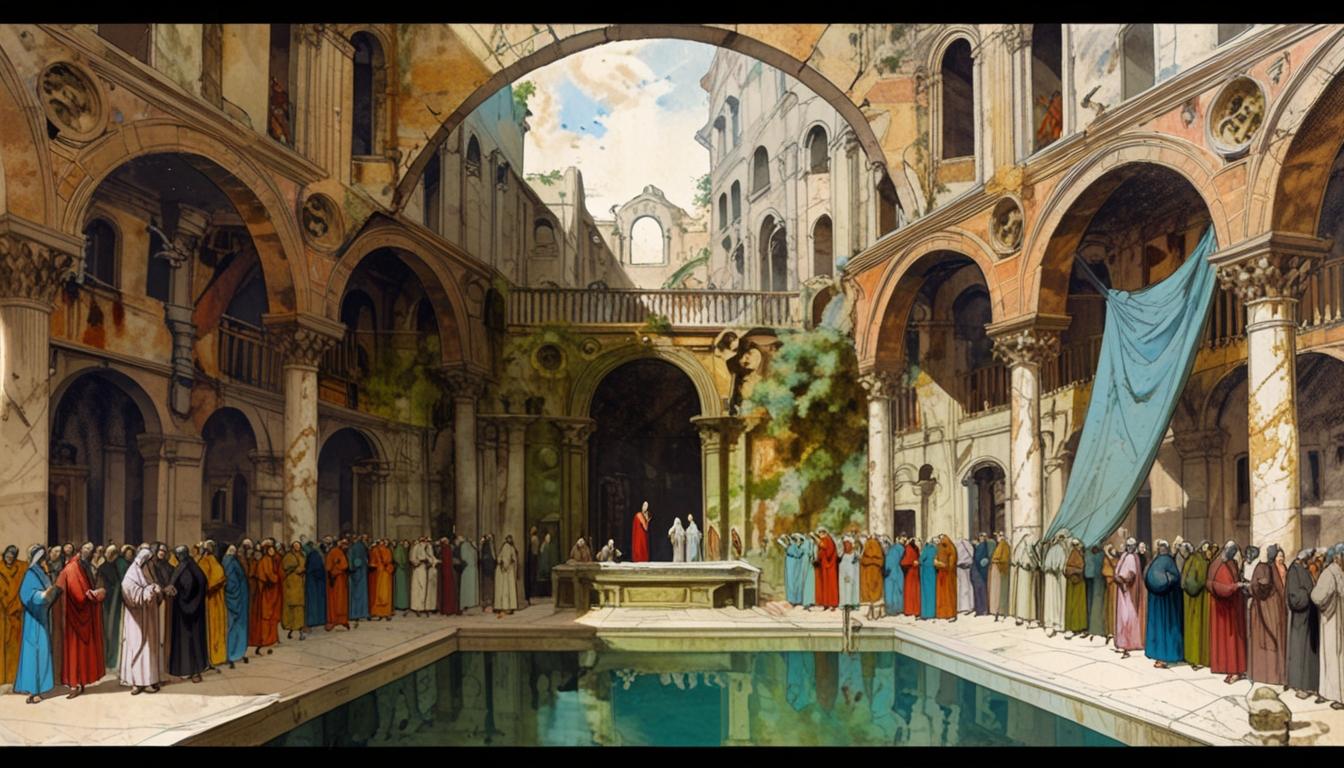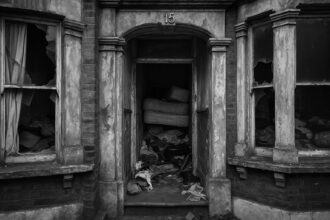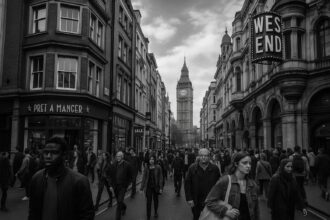Aberdeenshire Council officials face a frantic search for Paolo Veronese’s 16th-century painting ‘The Pool of Bethesda’, last seen in Peterhead over a century ago. With an estimated value of £13 million, the disappearance has sparked international academic interest and raised fears of a cultural scandal.
Panic swept through Aberdeenshire Council as a mystery involving a long-lost Italian masterpiece resurfaced, sending officials into a frenzied search for answers. The artwork in question is Paolo Veronese’s substantial painting, “The Pool of Bethesda,” an exquisite piece created in the 16th century that has changed hands many times, including a time spent gracing the walls of Catherine the Great’s Russian palace. Last documented as residing in Peterhead’s Arbuthnot Museum in the early 1900s, its current whereabouts are steeped in uncertainty and intrigue. Experts estimate its value at around £13 million, raising the stakes in this already complex narrative.
The journey to locate this significant artwork gained urgency in 2022 when academics from the University of Melbourne launched an international search, motivated by the painting’s historical ties to Australia. This renewed interest brought the missing masterpiece back into the public eye and ignited a wave of investigations by the Aberdeenshire Council. Despite the council’s initial silence regarding their efforts to locate the painting, revelations via Freedom of Information requests unveiled a chaotic internal response to the situation.
Staff at the council expressed feelings of being “thrown into the fire” upon learning of the academic inquiry. An internal email sent on January 29, 2022, indicated early concerns as one employee noted the “clues” they had discovered regarding the painting’s last known location. The urgency of the situation was palpable, with frantic emails sent at all hours as council officials sought to untangle the riddles of the painting’s past. As speculation swirled, theories ranged from the painting being buried underground in Peterhead to the possibility that a former librarian had disposed of it, deeming it worthless.
The saga began when the wealthy brewer James Volmer gifted “The Pool of Bethesda” to his hometown upon his death in 1883. It hung in Arbuthnot Museum for decades, unnoticed in terms of its true value until the Melbourne scholars revived interest in the piece. The profound historical connections included its past as part of the exhibiting arts of Venice’s Palazzo Grassi, its acquisition by Catherine the Great, and its later display in Australia.
In the wake of the academic interest, Aberdeenshire officials expressed exasperation at being blindsided by an inquiry that could lead to a “bad news” story about lost collections. Communications between staff revealed a palpable tension and urgency to discover what had happened to the 6ft by 12ft painting, particularly as media coverage began to escalate. Not only did the council feel compelled to locate the piece, but they were also motivated by the fear of reputational damage, knowing a high-value artwork seemingly went missing under their oversight.
As discussions progressed, the search expanded to incorporate potential leads from the National Gallery of Scotland to explore whether they might have any record of the painting. With every inquiry, however, it became increasingly apparent that the trail had grown cold. Internal communications hinted at a theory that in the tumultuous decades of the 1970s, numerous artworks were lost or disposed of during periods of what one staff member described as “terrible practices.”
Attempts were made to discern whether the painting might have been misplaced during wartime or if it had been given away during a period of significant curatorial reshaping within the museum. Employees speculated whether some of the artifact’s fate could be traced to an earlier, less discerning management that might have perceived the artwork as surplus to requirements. One particularly memorable theory suggested that prominent local figures might have had it painted over or hidden in an effort to preserve their image during a shifting social landscape.
Despite numerous academic and local efforts, the painting’s last known record—a documentation from 1905—is right now its only trace. An Aberdeenshire Council spokesperson confirmed that paperwork from the early twentieth century is being scrutinised, yet “there is, as yet, no useful information” to clarify what became of the piece.
The lingering questions among local and academic circles remain profound. Declarations of astonishment from Australian art historians emphasise that it would be scandalous if such an important cultural artifact had vanished without a trace, potentially even discarded. Three years into the investigation, speculation abounds, and with each inquiry, the artwork’s fate edges further into the realm of historical enigma.
As the months pass and anxiety among scholars and local authorities grows, the hope for a breakthrough continues to dwindle. “I am longing to know,” expressed an Australian academic, reflecting the mounting frustration felt across continents. The tale of “The Pool of Bethesda” is becoming one not just of a missing painting but of an intricate web of history, perception, and legacy, now symbolically lost in the mists of time.
Reference Map
Paragraph 1: [1], [2]
Paragraph 2: [1], [2], [3]
Paragraph 3: [1], [6]
Paragraph 4: [1], [4]
Paragraph 5: [5], [6], [7]
Paragraph 6: [1], [2], [4]
Paragraph 7: [1], [4], [6]
Paragraph 8: [1], [5]
Paragraph 9: [2], [4], [6]
Paragraph 10: [1], [5], [6]
Source: Noah Wire Services
- https://www.pressandjournal.co.uk/fp/news/aberdeen-aberdeenshire/6747657/aberdeenshire-council-missing-painting-mystery/ – Please view link – unable to able to access data
- https://www.bbc.com/news/uk-scotland-north-east-orkney-shetland-60290162 – An international search has been launched for a missing 16th-century painting, ‘The Pool of Bethesda’ by Paolo Veronese, last documented in Peterhead’s Arbuthnot Museum in the early 1900s. Experts estimate its value at £13 million. The University of Melbourne and Aberdeenshire Council are collaborating to locate the artwork, which was once displayed in Venice’s Palazzo Grassi and later acquired by Catherine the Great of Russia. The painting’s journey included a period in Australia before being gifted to Peterhead in 1882. The search continues as its current whereabouts remain unknown.
- https://www.pressandjournal.co.uk/fp/news/aberdeen-aberdeenshire/5344576/missing-peterhead-painting/ – Art historians are persistently searching for Paolo Veronese’s ‘The Pool of Bethesda,’ a £13 million painting last seen in Peterhead’s Arbuthnot Museum. Despite efforts by Aberdeenshire Council to investigate records from the 1900s, the painting’s fate remains a mystery. The artwork, measuring 6ft by 12ft and weighing a tonne, was once displayed in Venice’s Palazzo Grassi and later acquired by Catherine the Great of Russia. Its journey included a period in Australia before being gifted to Peterhead in 1882. The search continues as its current whereabouts remain unknown.
- https://www.pressandjournal.co.uk/fp/news/aberdeen-aberdeenshire/4152626/peterhead-missing-painting/ – Art historians are losing hope that a £13 million Italian painting missing from Peterhead will ever be found. Earlier this year, academics identified the final known whereabouts of Paolo Veronese’s ‘The Pool of Bethesda’ to be the town’s Arbuthnot Museum. But nobody seems to have any idea what happened to the huge 16th Century painting beyond the early 1900s. At the start of February, Aberdeenshire Council confirmed officials were ‘interrogating’ the record books for clues. Now more than two months on, an Australian expert who helped uncover its history is running out of hope.
- https://www.pressandjournal.co.uk/fp/news/aberdeen-aberdeenshire/3903030/pool-of-bethesda-painting/ – It was painted in Venice in the 16th century and shown off on Catherine The Great’s Russian palace walls. The Pool of Bethesda, a massive Italian artwork measuring 6ft by 12ft, has a storied history since being crafted by revered Renaissance master Paolo Veronese. But today, nobody knows where the £13 million masterpiece is. And remarkably, its last known home was Peterhead, where it hung for decades with seemingly nobody truly aware of its importance or value. No-one even knows for sure when it was removed from the town’s Arbuthnot Museum.
- https://www.scotsman.com/heritage-and-retro/heritage/has-a-missing-ps13m-venetian-masterpiece-gifted-to-a-scottish-museum-ended-up-in-the-tip-3650171 – For a little museum in a small Scottish town, it was an incredible gift – a Venetian masterpiece reportedly worth £13m at today’s values. Now, academics leading a worldwide search for Paolo Veronese’s ‘The Pool of Bethesda’ are growing increasingly frustrated in the hunt for the missing painting, with concerns it may have been long stolen, or even thrown in the tip. James Volmer, from a prosperous North East seafaring family which made part of its fortune in whaling, gifted the artwork to the Arbuthnot Museum in Peterhead in 1883, the year before his death in Australia where he pursued further riches in the brewing industry.
- https://news.stv.tv/north/historians-hunt-for-missing-painting-worth-13m-last-seen-in-peterhead – Art historians around the world are searching for a missing £13m masterpiece last seen in Aberdeenshire. A varied history, the huge 16th century Venetian painting ‘The Pool of Bethesda’ has hung in palaces around the world, but remarkably its last known location is Peterhead in 1904, housed in the town’s Arbuthnot Museum. Dating back beyond the 1800s, the painting is known to have hung in the Palazzo Grassi in Venice before landing in the hands of Catherine the Great at a London auction. Later it was given to an Aberdeen University rector, who is believed to have kept the painting on his estate near the city. Eventually, the multi-million-pound artistry was flown across the world to Australia and was exhibited at the Melbourne Athenaeum, where experts at the University of Melbourne suspected it was later raffled off.
Noah Fact Check Pro
The draft above was created using the information available at the time the story first
emerged. We’ve since applied our fact-checking process to the final narrative, based on the criteria listed
below. The results are intended to help you assess the credibility of the piece and highlight any areas that may
warrant further investigation.
Freshness check
Score:
8
Notes:
The narrative references recent academic interest from 2022, indicating updates are relatively recent. However, the core issue of the missing painting has been ongoing.
Quotes check
Score:
7
Notes:
A quote from an Australian academic is mentioned but lacks specific reference to its earliest known source online. The context suggests it could be original or recent.
Source reliability
Score:
8
Notes:
The narrative originates from a reputable regional publication, Press and Journal. This generally ensures reliability in reporting local news.
Plausability check
Score:
9
Notes:
The claims involve a historical and plausible scenario of a lost artwork, supported by details about past ownership and the search efforts. While speculative theories exist, they align with the context of art history.
Overall assessment
Verdict (FAIL, OPEN, PASS): PASS
Confidence (LOW, MEDIUM, HIGH): HIGH
Summary:
The narrative is plausible and recent, with a reliable source and no major red flags regarding quotes or content freshness. The plausibility of the story is high due to its historical context and the ongoing efforts to locate the painting.













